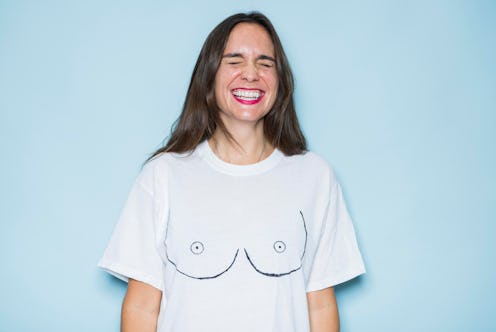Life
6 Things Never To Put On Your Nipples

The nipple is often one of the more forgotten parts of sensitive skin on the body (until it features in a Rihanna video, obviously), but it's more of a delicate flower than it seems. As anybody who's ever had an irritated nipple, a sebaceous cyst on the areola, or any kind of chafing can testify, treating your nipples badly does not pay. (Runner's nipple, anybody?) And there are certain substances that should be kept far, far away from your breasts' pointy parts, for the health of everybody involved.
Nipples have had a slightly interesting ride through history. Hippocrates deemed blood coming out of the nipples as a sign of madness in women (when likely they were just having some very severe medical difficulties), and Jane Sharp, the 17th century midwife, thought that women's nipples progressed from pink to blue to black as they grew older. (Redness or pinkness of the nipples was also meant to indicate that you were a virgin.) But for all the myths surrounding them, there are some very firm truths, most of which can be encompassed in one sentence: be careful what you put on your boobs, people. That includes everything from beauty aids to sexy substances to lingerie. Don't mistreat the nipple, or it'll pay you back and you will not like it.
Here are six substances that you definitely shouldn't put on your nipples, unless you're in the mood for a very uncomfortable party in your bra.
1. Hair Removal Creams
If you have hair growing on your nipples, I feel bad for you, son, but a hair removal cream will just add to your 99 problems. Nipple hair is more common in adult women than you might expect, and it can grow both around the rim of the nipple and from the actual skin itself. But using something like Nair to try and remove it is letting yourself in for a world of hurt.
XOJane chronicles a misguided journey into hair removal cream on the nipples, if you really want the gory details, but the basic lesson is: don't. The cream will likely act as a severe irritant to the sensitive skin of the nipple area and cause much more trouble than it solves. The glands may become infected, pores may get inflamed, and you will basically have a horror show on your torso. Hair removal on the nipples is a tricky one, but experts recommend judicious plucking or laser hair removal, if you must.
2. Any Untested "Warming" Or "Freezing" Lube
It's difficult to remember to pause in the heat of passion to make sure everything is OK with whatever substances you're using, but when it comes to sensation lubricants, which promise either heating or cooling effects, it's necessary to make sure they'll react well with the sensitive skin of the nipple.
Many lubricants for sexual use are designed to be used on very sensitive areas, but they can't control for everybody's sensitivity levels. Some women may find a small tingling, while a small minority may experience pain. For that reason, all the reputable brands, like Astroglide, recommend applying any new lube (particularly one with sensation aspects) to your forearm to see whether it reacts badly.
3. Soaps Containing Alcohol
This is a general tip: don't use soaps that dry you out on your nipple area. The round nubbins around the pink bit surrounding the nipple itself, the areola, are sebaceous glands that are designed to exude a little bit of liquid every now and then, to make sure your nipple stays soft and protected. (They're also called Montgomery tubercles, if you're feeling the need to be fancy.)
Using extremely drying soaps or alcohol-based cleaners, unless you've been specifically advised by a dermatologist, removes this protective excretion and dries out your nipple, raising the possibility of cracking and dryness-related problems.
4. Witch Hazel (If You're Not Breastfeeding)
Witch hazel is specifically recommended to breastfeeding mothers, but that doesn't mean it's something you should splash on your nipples willy-nilly to make them perkier. Witch hazel acts as an astringent and tightens tissue, which is excellent if your nipples are dealing with the swelling of a newborn's constant attention, but is not recommended for anybody who doesn't want to cause hardness and compression in their normal nipple tissue, or a restriction in their nipple blood flow.
5. Cheap Glue
Admittedly this is a slightly niche thing, but any burlesque performer will tell you that nipple pasties are not to be attached by any old glue stick you have around the house. As burlesque has entered the mainstream, so have pasties as an exciting addition to your usual lingerie cupboard, but what you apply to fasten them on is important to the health of the nipple underneath.
Professional burlesquers tend to attach their pasties with toupee tape, liquid latex, or spirit gum, the kind used by stage actors to fasten on hair. Don't try to fasten them with cheap paste or glue-sticks or you'll have a very hard time all round.
6. Double-Sided Tape
If you saw the picture of Kim Kardashian's "secret" to looking perky under plunging clothes this week, you may have gasped aloud: she swathed her entire breasts, including nipples, with double-sided tape. That's a large no-no, unless you put a shield underneath. Unless you're protecting your delicate nipple surface, a trauma like ripping off tape could damage its glands and pores, or even rip the skin. If you're planning on taping your boobs in any way, always put a cotton shield or some other custom-designed nipple protection underneath, to make sure that the removal process isn't a dangerous and uncomfortable one.
Want more women's health coverage? Check out Bustle's new podcast, Honestly Though, which tackles all the questions you're afraid to ask.
Images: Bustle, Giphy